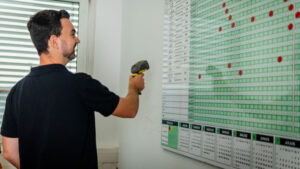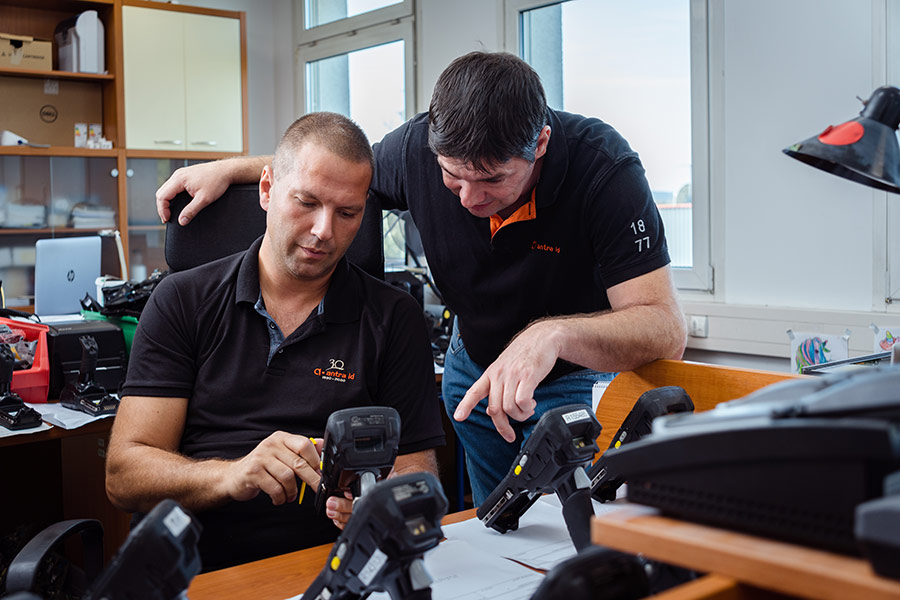This process is still done on paper or with less efficient solutions in many places. In contrast, digital concepts are now available to help companies save time, effort, and resources by ensuring a fast and accurate inventory.
An effective inventory solution can overcome the chaos prevailing in companies’ offices. Join us to hear how you can make inventory management faster, more accurate, and cheaper!
Inventory is a significant pain in the ass for companies. But the process is straightforward: you must count how many assets your company has in each location. What obstacles can I encounter if I use a paper-based or barcode system?
Inventory management poses fundamental challenges. If the person taking the inventory does not identify the items, i.e., does not recognize what the thing is. By this, I mean there are differences between tangible and intangible assets. For example, there can be a massive difference in price between chairs, and it is essential to be careful which ones are sold or discarded.
Inventory is carried out by persons who can assess the value of the objects…
This is the goal in theory, but it is a stark contrast in practice. In many cases, we are talking about a stockpile of 2-300 thousand assets. The fixed asset inventory is based on how it was received in the book inventory and whether it is included. It may contain foreign names or just codes, which makes it difficult. The list is done in pairs – a manager and an assistant – as two people must sign the inventory sheet. In larger companies, there are not 200 people who can identify all the fixed assets.
Let’s not just imagine inventory in the case of manufacturing companies but also in hospitals, for example, and in various public institutions, where everything from microscopes to ladders is a tangible asset, and they all fall into this category. It is not easy to recognize these devices.
If the company’s assets are not correctly marked, what problems can arise?
Smaller firms usually do not mark fixed assets; they buy the equipment, use it, and write its name on an inventory sheet once a year. Not identifying the assets transfers the whole problem to the accounting side.
The possibility to identify each asset by barcode is given, which is an excellent starting point. This solution can have problems; on the one hand, you have to put these codes on visible surfaces, which can be quite vulnerable.
What is the difference between SMEs and large companies? The former requires less effort to inventory, but a large company has a lot of assets to count. What are the differences in terms of size?
First and foremost, the rigor with which the physical assets were recorded. Large companies tend to have a more consistent administration, which results in a higher-quality inventory. It is not uncommon to find 2-300,000 fixed assets in such places, which are highly dispersed. Such an inventory requires a team of hundreds of people to go through everything, which is a considerable human resource.
A distinction can be made between the inventory of SMEs and large companies. For what size can you say that RFID is worthwhile, and when is it worth the investment?
There is a speed difference between barcode inventory and RFID technology. For a few thousand assets, manual or bar-code inventory is more cost-effective, while it is worthwhile to use state-of-the-art technology.
 What does a company gain by using RFID technology instead of barcode inventory?
What does a company gain by using RFID technology instead of barcode inventory?
RFID technology enables unique identification. Inventory clerks mark items on the inventory sheet passed to the finance department, who cross-check them against the book inventory. Inventory shortages/surpluses are attempted to be reconciled.
In comparison, barcode inventory provides accurate information, but the process is much slower as each barcode has to be searched for. You must write down what is missing from a list if not found.
As you mentioned, the barcode technology is more accurate. On the other hand, RFID reads objects automatically, so its accuracy can also be found here.
On the other hand, RFID technology is based on digitally communicating with microchips placed in space, i.e., emitting a search signal to which these devices respond. These passive systems do not need a battery and are less expensive to maintain than other systems. However, with this process, we are not in physical contact with the asset, so a simple operator can perform the inventory process.
How much are you seeing companies catching on to RFID? Roughly what percentage of companies are using advanced solutions, and how many are doing it traditionally on paper?
Based on current trends, it can be said that firms have suddenly become sensitive to their fixed assets. In larger companies and the SME sector, they have started to pay more attention to their inventories. They are looking more closely at what they are spending on. A natural, acceptable ‘good stewardship’ approach has started in practice. Part of this is the need to keep an inventory of assets.
What does Antra ID offer for the needs that arise? How much time is needed for the installation, and what return on investment can businesses expect? I’m also interested to know how your system works!
Antra ID Ltd. has been dealing with automatic identification and data collection processes for about 30 years. During this period, we have developed an RFID-based Instant Inventory solution, into which we have implemented our experience. It is a vehicle identification system based on a robust data collection platform in which RFID, barcode, and manual data can be collected.
We calculated that a system could pay for itself in one to five months. Around 250 mobile terminals are needed for larger systems with simultaneous use. The payback figures are highly variable. The initial costs of implementing such systems are higher, as everything has to be set up.
Let’s say we can reduce the inventory time to a fraction. When calculating the return on investment, we also have to consider the downtime, the number of staff involved, and the cost of these. We have a solution where the inventory process has been accelerated by a factor of 22, and the profits have been so high that they no longer do it once a year but have introduced a continuous inventory solution.
Botond Némethi,
NEW technology magazine



